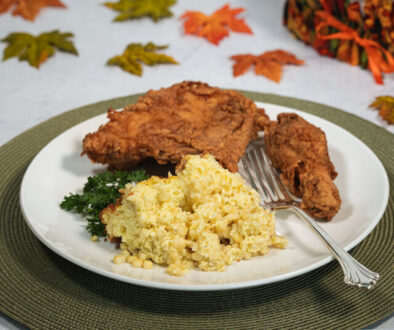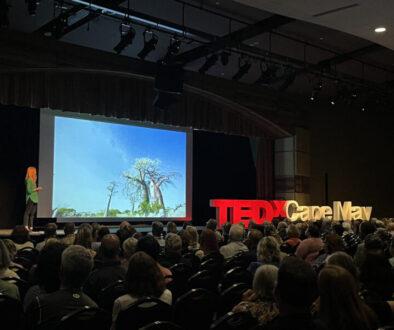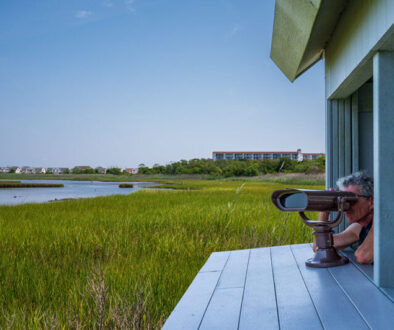Going Native
The case for native plants

Choosing the right plants is one of the toughest tasks for any gardener when landscaping a new yard or even reinventing an overgrown garden. That’s especially true in Cape May, where the ocean winds and sandy soil can make it hard for some plants to grow but force you to battle sometimes lush and often uninvited groups of others.
That challenge gets even more complicated when you consider how the plants you choose are going to impact the birds, butterflies, and other wildlife that make the Cape May area a migration nexus.
University of Delaware Professor Doug Tallamy recently spoke at the Cape May Point Science Center at the invitation of the Cape May Bird Observatory. His message for Cape May gardeners: Add more native plants to your yard and try to eliminate the invasive plants and vines.
Fortunately, the hunt for these plants and information on how to use them has gotten easier in recent years, with more garden centers stocking them and nature centers and other resources offering educational opportunities to learn more about them.


Tallamy says one way to get started in your own yard is simply to think of plants as bird feeders.
“The message should be a little special for Cape May because you’re such an important [migratory] stopping point. You need as much bird food as possible,” he said. “The migrating birds moving south, they’re eating berries that are there, they’re eating insects too, particularly caterpillars. So, getting the Porcelain Berry under control, replacing the White Mulberry with oak trees, the things that are actually going to make a lot of caterpillars for those migrating birds—that would be a huge step forward.”
A best-selling author and professor in the department of Entomology and Wildlife Ecology at the University of Delaware, Tallamy has taught insect-related courses for 45 years. His research has focused on understanding how insects interact with plants and what that means for diversity in animal communities.
Tallamy has spoken several times in Cape May County, and the group gathered at the former retreat for nuns in Cape May Point this May had plenty of questions for him. The audience was also able to see a wildlife and pollinator garden firsthand in the Science Center’s center courtyard.
Tallamy also signed copies of his latest book, How Can I Help? This new book is a compilation of many of the questions he’s been asked over the years.
A common question from gardeners is why can’t insects just adapt and use non-native species for food since the insects can become resistant to pesticides?


“The answer is most insecticide resistance is not really adaptation,” he said. “The resistance already occurred in the population of a very small number of individuals. The others that aren’t resistant die, but the survivors mate. It only takes a few generations until everybody’s resistant.”
But adapting to a new host plant is not so simple for an insect. “What they have to do is change sensors in the antennae; sensors in the tarsi; sensors in the ovipositor; sensors in the mouthparts of the hatching larva, and their physiological ability to handle the toxins of the new plant,” Tallamy explained. “And all those changes have to happen simultaneously. So, it does happen, but it’s really rare.”
Tallamy said some insects can expand the range of the host plants they use to lay their eggs, and that their offspring eat for food. A great example is the Swallowtail Butterfly.
This beautiful black and spotted butterfly can lay eggs on non-native plants like carrots, dill, and Queen Anne’s lace. Its caterpillars can eat those plants because they are all closely related members of the carrot family. That is an example of expanding the range of host plants. “It’s always close relatives of their plant here that they co-evolved with,” Tallamy said.
After gardeners become convinced that they want to add more native plants, the problem for some has been finding information on the best local plants for pollinators and then finding where to get them. Pollinators include insects like bees, beetles, butterflies, and moths that carry pollen to help fertilize plants.
New Jersey Audubon’s Cape May Bird Observatory (CMBO) is a local resource for residents curious about native gardening, and its Nature Center of Cape May hosts annual native plant sales. CMBO sponsored Tallamy’s talk as part of its Diane Cornell Wildlife Garden Project, which was initiated to educate the Cape Island community about the links between native plants and pollinating insects, birds and other wildlife.
The project was started in Diane’s memory by her wife, Margaret Flinner, as a way to celebrate her love for Cape May Point. The fund also helps support the CMBO’s Northwood Center on Lake Lily, where efforts have been underway for the past decade to remove invasive vines and plants and replace them with natives. A seed library outside the building features native species.
“After we retired, we spent more time at the Point, birdwatching and enjoying nature. That’s when Diane really got into native gardening and realized how important these plants are to birds, bees, and monarch butterflies during their incredible migration,” said Flinner.
The efforts to clear Northwood and reinvigorate the property as a welcoming home for wildlife had already received a major boost from the efforts of the family of the late Ryan DeWitt. Ryan was an avid birder who traveled all over to look for birds, and he frequented Cape May, where his parents have a second home.


His family sponsored and helped with the physical labor to clear and build a path behind the Northwood building, now known as the Ryan DeWitt Memorial Trail.
Mary and Joe DeWitt said their sons Ryan and Greg used to visit the Northwood Center to watch birds, but they could not get behind the building because it was so overgrown. Ryan’s friends wanted to create a memorial for him and wanted to place a bench on the property in his memory, but former CMBO Director David LaPuma had a bigger idea.
“It went from a bench to literally this,” said Joe DeWitt, pointing across the wooded path, now lined by native flowers and shrubs.
Clearing the small, wooded patch has made a big difference for birds and birders on the north end of Lake Lily. The work to restore the habitat continues.
“I now call it a model habitat, providing appropriate food, water, and shelter. It’s an oasis for resident and migratory birds,” said Brett Ewald, current director of CMBO. “It’s often active when other areas become quiet.”
During migration, “it wouldn’t be a surprise on a good day to see ten species of warblers among a range of other bird species, such as thrushes, tanagers, grosbeaks, and vireos,” he said.
Pat Sutton, a former program director at CMBO, has been a long-time proponent of native plant protection and gardening. She has been a major force behind the education of many of the native gardeners in Cape May County through her CMBO courses and her garden workshops.
Sutton says she became interested in native plants while leading bird walks on Cape Island in the 1970s and 1980s. She watched what the birds were eating and began to document it.
At the time, invasive Clematis with its sweet-smelling mane of white flowers or Porcelain Berry, an Asian grapevine-like plant, were not yet an apparent part of the landscape at the Cape May Point State Park or Higbee Beach Wildlife Management area in Lower Township
Invasive species are those that are not native and crowd out other plants. They can sometimes grow better than local ones since their own natural enemies are absent. The invaders often provide little nutrition for local wildlife, and the vines can become so prolific that they choke trees and bushes. In areas where there are deer, they can compound the problem. Deer typically don’t like invasives, and they prefer to eat native species. One of the biggest offenders in woodlands can be English ivy, planted originally by gardeners as ground cover but a pervasive spreading vine that can smother trees.
“I witnessed firsthand how crucial it was that native plants were available, so it was just a no brainer to try and get people interested in birds to make the connection that their own properties could be an oasis for these migrants,” Sutton said. “And that would bring them joy. They would get to see the migrants in their yards if they planted native plants.”
Tallamy said public education efforts have increased overall. One route to success has been to encourage local and state governments to become interested, and he’s seeing a change as he speaks to groups across the country.

“The state of Delaware banned the sale of invasive plants. That’s a step forward. There are more and more states that are banning at least selective non-natives,” Tallamy said. The New Jersey state legislature was also considering a bill this spring to ban the sale and propagation of certain invasive species.
“Elected officials are coming to my talks. Mayors and state senators. That’s a good thing,” Tallamy said.
For instance, Fort Worth, Texas, Mayor Mattie Parker came to hear him speak. Tallamy said Parker is concerned about the pace of real estate development in her area. “She’s introduced a plan to save 10,000 acres in Fort Worth. This is the mayor initiating it. That didn’t used to happen. That’s very positive.”
Cincinnati Zoo in Ohio is another place Tallamy has visited, and it has a strong public education program. Visitors can easily find information on native gardening. In fact, the zoo has a large native plant program and sells plants from the 300 species it grows on its own farm.
Nature centers and organizations like the zoo are important.
“It’s happening all over the place. It really has become part of the culture. It’s not just a few weirdos selling plants on the street corner,” said Tallamy. “The demand for native plants exceeds supply, so it’s a business opportunity.”
Brian Jorg, manager of the Cincinnati Zoo native plant program, said part of his mission has been to educate growers as well as the public. Jorg collects seeds from plants around the Midwest and propagates them. Gardening for monarch butterflies is often one of the first ways homeowners begin to see the benefits of growing native plants. The same is true in Cape May.
Monarchs use milkweed as a host plant, and while gardeners may find just a few varieties in the nursery, Jorg said there are many more growing in the wild. The many varieties of Goldenrod are also an excellent source of nectar for monarchs, since it blooms later in the season when migrating monarchs are making their way to Mexico.
“Goldenrod has a bad reputation because people start sneezing and they look out the window, and they see fields of goldenrod, and they say, ‘that’s making me sneeze.’ The real reason you’re sneezing is ragweed, not goldenrod,” Jorg said, adding that Seaside Goldenrod is a good garden plant for Cape May.
West Cape May nursery owner Cindy Franklin agrees that monarchs have sparked interest in native gardening, and that customers come in specifically looking for plants for butterflies and hummingbirds.
There’s been a surge in interest in native gardening this year. In part, she credits efforts by West Cape May, which is encouraging gardeners to plant them. Franklin owns Cape Island Gardens, known by some locals as “10,000 plants” for the sign advertising its plant collection at the end of her driveway on Broadway.
“There’s an upswing in it, no doubt about it,” said Franklin. “And it’s also the growers. Finally, Centerton Nursery in Bridgeton is offering all these new natives. It’s hard to find natives from the growers.”
Small growers have been providing native plants, but not with the volume of supply that would be required to populate garden centers around the state with enough plants. Many of these growers have small distribution networks and some have other full-time jobs.
Centerton Nursery has been working with the Native Plant Society of New Jersey, whose mission through its 15 chapters is to educate the public on the benefits of native species.
Centerton is a three-generation Blew family-run grower, and one of the most recent area nurseries to increase its focus on native gardening. Their native plants are clearly marked on the “True Blew” labels on their containers.
“It’s growing for them,” said Bobbie Herbs, who co-chairs the society’s Independent Garden Center Committee along with Kim Rowe. “This year is actually the first year they had shrubs. They offered 10 or 11 shrubs which is great.”
Herbs and Rowe have been spending time with independent garden centers to educate them and the public on which plants would be beneficial for home gardeners.

“Last season, we had over a dozen ‘Pollinator Days’. Chapter liaisons spend a day at a garden center sharing the benefits of native plants with customers. We expect to hold another 12 in 2025,” notes Herbs. She and Rowe received Rutgers University Environmental Stewards certification for creating the garden center program.
They encourage centers to carry straight species of native plants but also work with them to understand which cultivars are beneficial to insects.
Cultivars are cultivated varieties that have been bred for specific characteristics. Some have been altered so much that they have lost their usefulness to wildlife. Herbs said gardeners should look for cultivars that more closely resemble the straight native, without double flowers or dramatically different colored leaves, like reds or purples.
Herbs said gardeners are recommended to use about 70% native species in their gardens as a minimum. “So, 70% and throw in a bunch of annuals. There’s no issue with that as long as they are not invasive,” she said. Annuals are also an important source of nectar for pollinators, and they add splashes of color to the garden that can last into the fall.
Tallamy says the biggest challenge for pollinator gardens is to provide blooms all during the season. “You want early season blooms, things like Redbud, things like native Willows. They’re blooming first and are really important for our native bees. We’ve got 3,600 to 4,000 species of native bees, and they need to forage all season long—they don’t need it just in May.”
Midsummer is a difficult time because not many native plants are blooming. Tallamy suggests Buttonbush, Clethra, and the native Winterberry and American hollies. “They (hollies) get tiny little flowers. They’re not pretty for us, but they’re great pollinator plants.”
The Virginia Creeper vine, which many gardeners pull out, is also great for pollinators. “Then in the fall, the very best ones are the ones that are supporting the best specialist pollinators and that would be Goldenrod, native Asters, and perennial sunflowers. Those are the ones I would focus on.”
There are plenty of other good species for gardeners to be aware of that may already be in their yards. Tallamy said oak trees, for instance, support 557 species of caterpillars in the mid-Atlantic region.
“The message is that everybody has a responsibility to be a good steward of the piece of the earth that they can control. That’s going to be their private property. The public places in Cape May are extremely important too because of their value to birds. But you know, look at the tourism that Cape May gets because of birds. I think the public officials are on board. But they are not done. It’s just an ongoing project, and I would just encourage them to continue.”



